
Red cabbage is not only vibrant and delicious but also packed with nutrients. Proper storage is essential to preserve its freshness and health benefits. This guide will delve into how long red cabbage can last in the fridge and the best ways to store it for maximum shelf life.
General Shelf Life of Red Cabbage
Red cabbage, like other cabbages, can vary in how long it stays fresh based on whether it is whole or cut:
- Whole red cabbage: When stored correctly, can last for up to 2 weeks in the fridge.
- Cut or shredded red cabbage: Should be used within 2-3 days for the best quality.
Storing red cabbage properly can make a big difference in maintaining its texture, flavor, and nutritional value.
How to Store Red Cabbage for Maximum Freshness
Storing Whole Red Cabbage
Whole cabbage is relatively hardy if kept in the right conditions. Follow these tips to prolong its shelf life:
- Temperature control: Keep your fridge between 32°F to 40°F (0°C to 4°C), ideally in the crisper drawer where humidity is higher.
- Avoid washing before storage: Excess moisture can lead to faster spoilage. Wait to wash the cabbage until you’re ready to use it.
- Keep it unwrapped or use a loose plastic bag to allow for ventilation.
For further details on using red cabbage in various dishes, you might want to check out the ultimate guide to red cabbage recipes – delicious and nutritious, which provides creative recipe ideas.
Storing Cut or Shredded Red Cabbage
Cutting or shredding cabbage shortens its shelf life significantly due to exposure to air. Here’s how to store cut cabbage:
- Wrap tightly: Use plastic wrap or place the cut cabbage in an airtight container to prevent moisture loss.
- Moisture retention: Add a damp paper towel inside the container to keep the cabbage fresh and crisp.
- Consume quickly: Aim to use cut cabbage within 2-3 days to avoid spoilage.
If you’re interested in tips for keeping other ingredients fresh, such as dips, check out how long will spinach dip last in the fridge for comparison.
Signs of Spoilage
Before using red cabbage, ensure it’s safe to eat by checking for these common signs of spoilage:
- Discoloration: Red cabbage that turns brown, yellow, or develops dark spots is likely past its prime.
- Texture: Wilted, limp, or slimy leaves indicate that the cabbage is no longer fresh.
- Odor: A sour or off smell is a strong signal that the cabbage has spoiled.
Tip: Always inspect your cabbage before using it in any recipe, especially if it has been in the fridge for more than a week.
Extending the Shelf Life of Red Cabbage
If you don’t plan to use your cabbage soon, there are methods to preserve it for a longer period:
Freezing Red Cabbage
Freezing is a great option if you need to keep cabbage for an extended period:
- Blanching: Bring water to a boil and submerge the cabbage leaves for 2 minutes. Immediately transfer them to an ice water bath to stop the cooking process.
- Dry thoroughly: Make sure the leaves are completely dry before placing them in freezer-safe bags.
- Label and store: Mark the date on the bags and store them in the freezer. Red cabbage can last up to 8-12 months when frozen properly.
For more on how to freeze and store different condiments, take a look at can you freeze soy sauce?.
Pickling Red Cabbage
Pickling not only extends the shelf life but also enhances the flavor:
- Slice thinly and place in a jar.
- Add pickling solution: Vinegar, salt, and sugar are common ingredients.
- Refrigerate: Pickled cabbage can last for several weeks when kept chilled.
Common Mistakes to Avoid When Storing Red Cabbage
Ensure your cabbage stays fresh by avoiding these common storage mistakes:
- Storing near ethylene-producing fruits: Fruits like apples and bananas release ethylene gas, which accelerates spoilage in vegetables.
- Excess moisture: Leaving cut cabbage wet can promote mold growth.
- Improper sealing: Not using airtight containers can lead to quicker drying and spoilage.
How to Make Red Cabbage Last Longer
These practical tips can help prolong the freshness of your red cabbage:
- Separate storage: Keep cabbage in the crisper drawer or a separate part of the fridge.
- Moisture control: Use a paper towel to absorb excess moisture when storing cut cabbage.
- Inspect regularly: Check for signs of spoilage before each use.
FAQs About Red Cabbage Storage
Can I eat red cabbage after it’s been in the fridge for a week?
Yes, as long as there are no signs of spoilage like discoloration, slimy texture, or an off odor.
What happens if I eat spoiled cabbage?
Eating spoiled cabbage can lead to gastrointestinal discomfort or food poisoning. Always err on the side of caution.
How do I tell if red cabbage has gone bad?
Look for visual cues like discoloration and texture changes. If it has a sour or musty smell, it’s time to discard it.
Can I store cooked red cabbage, and for how long?
Yes, cooked red cabbage can be stored in an airtight container in the fridge for up to 5 days.
Nutritional Benefits of Fresh Red Cabbage
Eating fresh red cabbage is a great way to include vitamins such as Vitamin C and K, as well as antioxidants that support overall health. Proper storage methods can help maintain these nutrients, which is crucial for getting the most out of your food.
If you’re interested in the nutritional value of other similar ingredients, you might find the ultimate guide to red cabbage recipes – delicious and nutritious helpful.
Final Thoughts
Storing red cabbage correctly can significantly impact how long it stays fresh and nutritious. By following these guidelines, you can enjoy the crisp, healthy qualities of red cabbage for up to two weeks and beyond. Implement these tips in your kitchen routine to minimize waste and make the most of this vibrant vegetable.
This comprehensive guide provides everything you need to know about the proper storage and shelf life of red cabbage. Whether using it fresh or preserved, maintaining its quality will ensure flavorful, nutritious meals.
